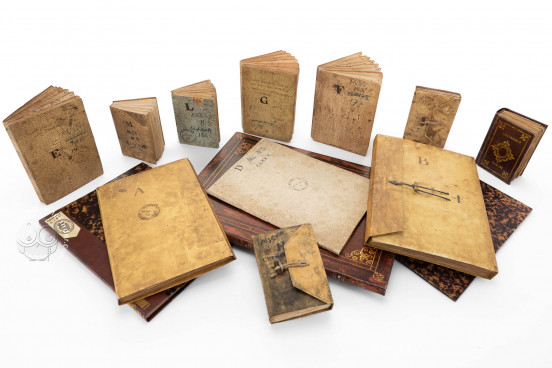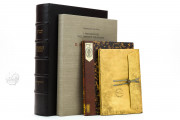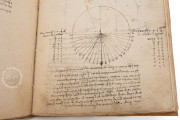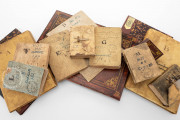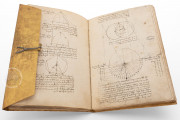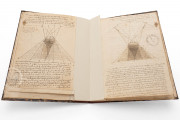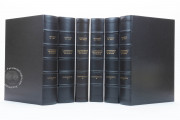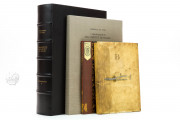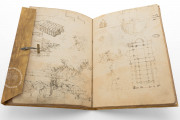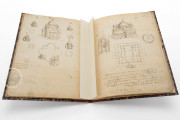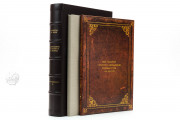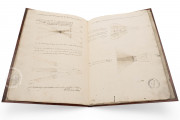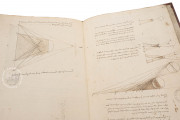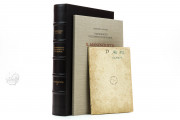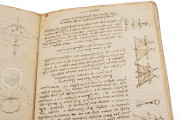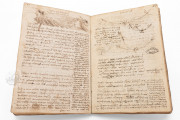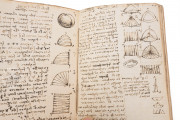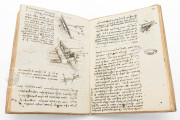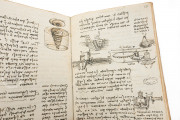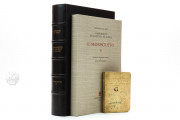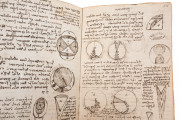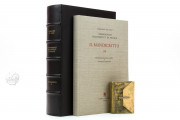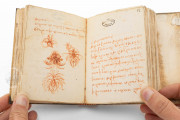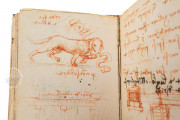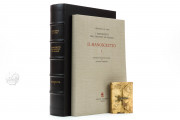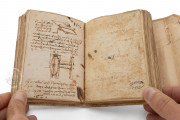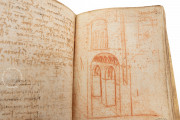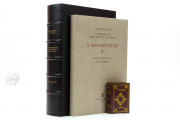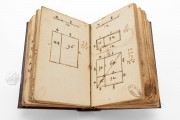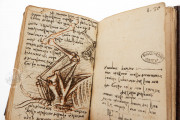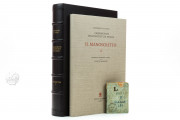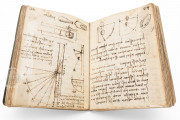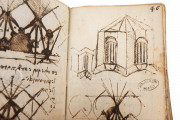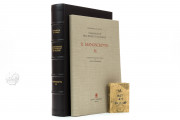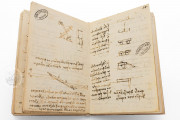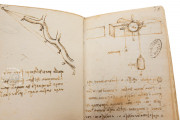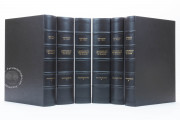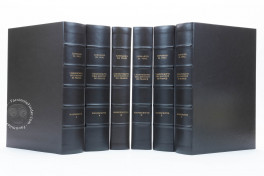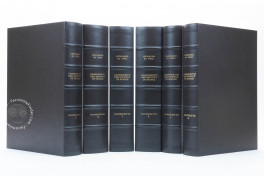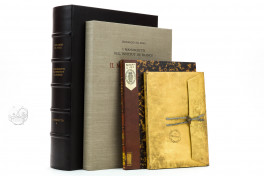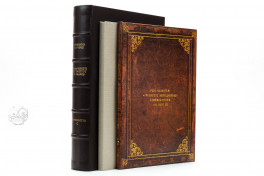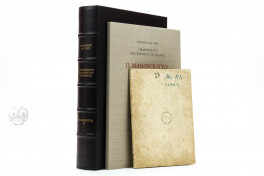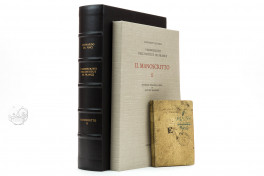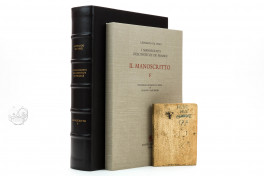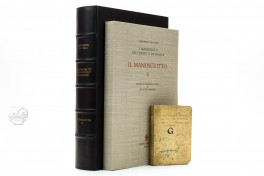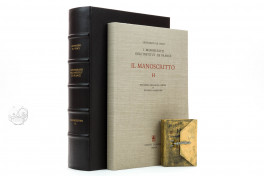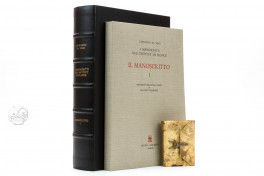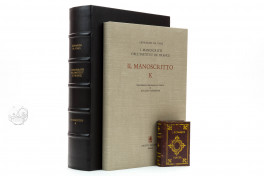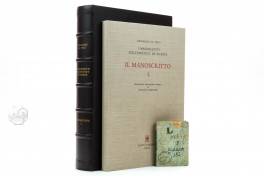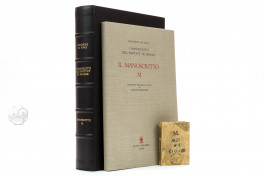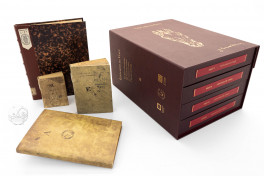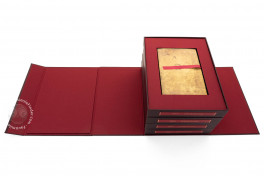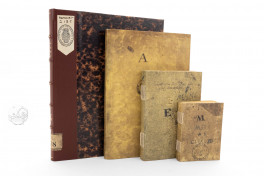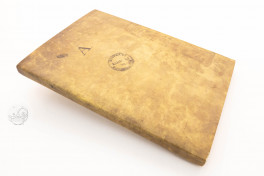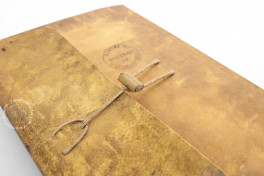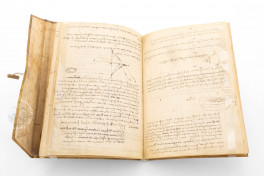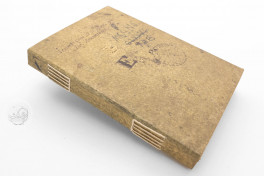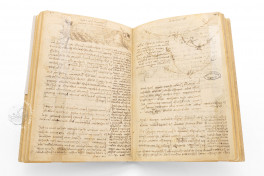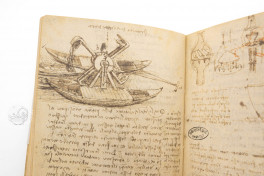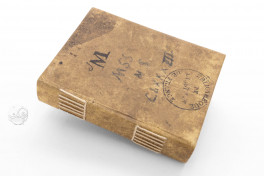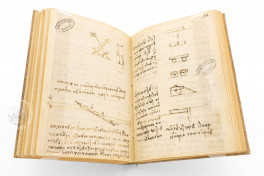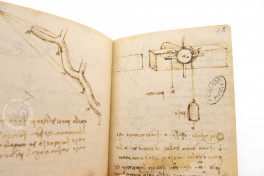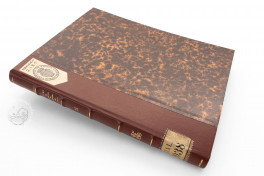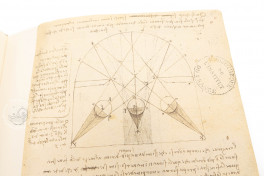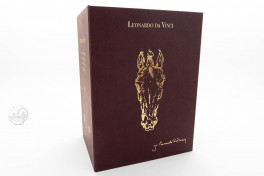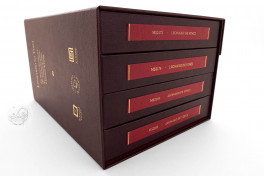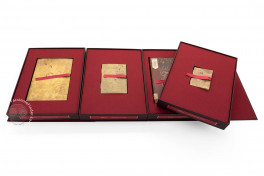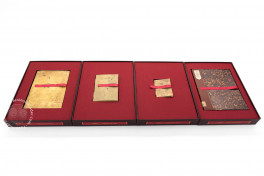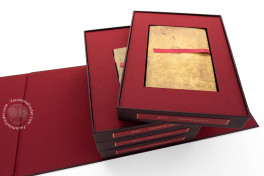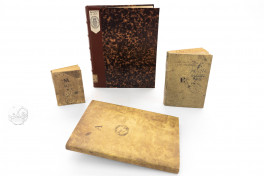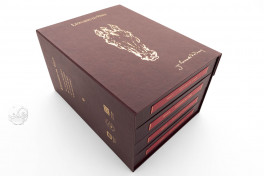The manuscripts taken from the Biblioteca Ambrosiana in Milan to Paris by Napoleon in 1795 consist of twelve codices, labeled A to M. They offer an exceptional insight into Leonardo’s life and works, covering a wide array of topics from geometry, physics, and mechanics to audacious technological concepts. These manuscripts intertwine autobiographical elements with observations on literary and artistic themes regarding the essence of the soul.
Enriched with masterful drawings, the smaller-sized notebooks serve as pocket-sized records where Leonardo captures fleeting thoughts, surprising ideas, and personal notes with acute perspicacity and quick sketches. The larger notebooks feature more elaborate writings and drawings, including outlines for treatises on hydraulic sciences, flying machines, architecture, optics, and vision problems. These topics, particularly those related to the "science of the painter," find a more developed form in his Treatise on Painting.
Manuscript A
Manuscript A was initially part of Pompeo Leoni's collection, a Milanese sculptor who retrieved a significant number of Leonardo da Vinci's writings and drawings from Giovanni Melzi, Leonardo's disciple and designated heir. Later, the pocket notebook became part of Count Galeazzo Arconati's collection, who donated it to the Biblioteca Ambrosiana in 1637. In 1797, Napoleon ordered its transfer from Milan to Paris.
Originally comprising 114 pages, it was later mutilated, reducing the number of sheets to 63. The topics discussed in Manuscript A can be categorized under two headings: Painting and Physics (Mechanics). They delve into Leonardo's dual identity as both an artist and an engineer, united by a shared fascination with motion and forces. The autographic numbering proceeds from beginning to end, which is atypical in Leonardo's works.
Manuscript B
Composed in the middle of his life, Manuscript B stands out as the oldest among Leonardo's surviving manuscripts, distinguished by a writing style and initial script different from his later works.
Leonardo describes himself as "omo sanza lettere" (literally, a man without letters), highlighting his self-taught education despite an initial rejection of formal schooling. Manuscript B illustrates how Leonardo drew from various sources to expand his knowledge, although his education in certain liberal disciplines remained limited by the midpoint of his life. Furthermore, the manuscript portrays Leonardo adopting a critical stance towards his contemporaries while asserting authority in defending painting as a discipline requiring scientific and theoretical understanding.
The manuscript touches on various topics, from mathematics to perspective, from war machines to flight projects, reflecting Leonardo's wide range of interests and his incessant curiosity.
Supplement A and Supplement B
Between 1841 and 1844, Count Guglielmo Libri, who had sought refuge in France and become a naturalized French citizen, conducted official inspections of various French libraries, due to the aftermath of Napoleon's transfer of works of art. Accused of stealing manuscripts, he fled to England with a substantial haul, including parts of the notebooks A, B, and E from the Institut de France. Some of this material was lost.
Using the last 34 pages of Notebook A, obtained by cutting 17 bifolios in half, Libri created a volume where each page was placed inside a paper bracket and then sewn into the binding. The title page reads "Notes & Dessins de Leonard de Vinci," featuring his signature and the date 1875. To conceal their origins, he erased Leonardo's original numbering. He treated the remains of Notebook B similarly.
Both volumes were sold and became part of Lord Ashburnham's library, cataloged as 1875/2 for A and 1875/1 for B. After lengthy negotiations, the volumes were returned to France and placed in the National Library with the shelfmarks Italien 2038 (A) and 2037 (B). They were eventually returned to the Institut de France, receiving the shelfmarks 2185 and 2184.
Manuscript C
Manuscript C, bound in leather and measuring 307 x 220 mm, consists of sixteen bifolios folded into thirty-two pages. Decorated in gold with ornamental designs, its cover plates feature inscriptions at the center of the first plate. The numbering of pages varies, indicating alterations in page order after Leonardo's death.
Featuring precise writing and drawings made primarily with rulers and compasses, the manuscript reflects Leonardo's tendency towards fragmented composition without a solid narrative thread. Despite this, it discusses light and shadow from a scientific perspective, along with insights into mechanics, hydraulics, and perspective.
Notably, Manuscript C has a unique ownership and transfer history, avoiding dispersion by Pompeo Leoni and ending up in the Ambrosiana Library before its transfer to the Institut de France.
Manuscript D
Manuscript D is a notebook containing five bifolios stitched inside a grey cardboard cover, measuring 228 x 162 mm. The text, written in a very regular and compact script, suggests it is a fair copy, with minimal cancellations. Most pages contain thirty-eight to forty-nine lines, with diagrams and brief annotations related to the study of eye anatomy and light paths occupying about one-third of the width on the right side. Three pages are dedicated entirely to annotations without diagrams.
Although there is consensus on dating Manuscript D to around 1508, Corbeau suggests a period between 1513 and 1516, during Leonardo's time in Rome, based on its thematic focus on anatomy and optical devices.
Manuscript E
Manuscript E, created between September 1513 and 1514 towards the end of Leonardo's life, originally comprised 96 pages as noted by Melzi, but only 80 remain due to theft.
A significant portion is dedicated to mechanical physics, showcasing Leonardo's contributions to the field. It also includes geometric and mathematical exercises, demonstrating his practical approach to mathematics for engineering and art purposes. Additionally, Manuscript E delves into Leonardo's theories of painting, perspective, and representation of motion, reflecting his view of painting as a science.
Despite Leonardo's autograph numbering suggesting a normal direction of writing, there are indications that he did not always follow this, showing a flexible approach to organization.
Manuscript F
Manuscript F comprises 96 sheets distributed in 6 booklets of 8 bifolia each, with dimensions of 145 x 100 mm, stitched and enclosed in a cardboard cover. It contains autograph writings by Leonardo and autograph numbering of the sheets, indicating almost intact transmission to Pompeo Leoni.
The manuscript begins in Milan on September 12, 1508, with red pencil and inked-over indications, suggesting concentrated work on limited themes. The homogeneous content and absence of blank pages suggest continuous work, possibly without significant interruptions.
Focused primarily on hydraulics, optics, and geometry, the manuscript reflects a methodical and concentrated approach, with blocks of consecutive pages dedicated to each topic. Manuscript F also addresses celestial bodies, motion, and light, with rich self-citations and references to Leonardo's works, indicating reflection on the organization and publication of his studies.
Manuscript G
Manuscript G, part of Pompeo Leoni's collection, is preserved with its original carton cover. It primarily explores the application of botany to painting, emphasizing the observation of light, shadow, and form in plants and its relevance to art.
The manuscript delves into geometry and various scientific and technical explorations, including water studies, weights, and mechanical devices. It also contains studies on the motion of elements, such as air and water, showcasing Leonardo's interdisciplinary approach to understanding the natural and mechanical world.
Additionally, Manuscript G offers reflections on the unity of science and practice, the certainty of mathematical sciences, and observations on natural laws governing the physical world. It includes advanced speculations on topics like the rotational motion of the earth and celestial bodies, anticipating later scientific discoveries.
Manuscript H
Manuscript H comprises three smaller Vinci notebooks bound into a single volume. These "quaderni," measuring 128 x 90 mm, were similar to what Melzi referred to as "librettini" in Codex Urbinate 1270. Leonardo often carried these notebooks in his pocket, using red or black pencil to make rapid preliminary notes, which he later elaborated upon with ink at home.
Manuscript H focuses on various subjects, including hydraulics and the dynamics of water, containing several engineering designs. Specific notes within the manuscript help date certain entries to the years 1493-1494, providing a contextual timeline for Leonardo's work on these subjects.
Manuscript I
Manuscript I comprises two original Leonardo notebooks, both in sixteenth size, approximately 100 x 70 mm, exhibiting uniformity in size despite slight variations. The manuscript's light leather binding, trapezoidal flap, and unique labeling, including its classification as "I" and various other inscriptions, provide insight into its physical attributes and historical handling. The notes within suggest use over several years.
Covering a wide range of topics, Manuscript I includes geometry, water studies, mechanics, and extensive Latin grammar notes. The inclusion of Latin grammar studies, verb conjugations, and syntax indicates Leonardo's efforts to improve his knowledge of the language, likely influenced by his interactions with contemporary scholars. Additionally, the manuscript features undeciphered writings and drawings.
Manuscript K
Manuscript K consists of three original notebooks, totaling 128 pages distributed across quires of 16 sheets each. Unlike other Leonardo manuscripts that transitioned from the Leoni collection to the Arconati collection, Manuscript K was donated by Count Orazio Archinti to the Biblioteca Ambrosiana in 1674, showcasing a distinct pathway in the preservation and dissemination of Leonardo's works. The manuscript was bound in red leather with gold decorations.
Covering a wide range of subjects, from geometry and Euclidean studies to considerations on water, flight, anatomy, and mechanical devices, Manuscript K contains extensive notes on geometry, particularly focusing on the study of Euclid's elements.
Manuscript L
Manuscript L comprises six quires of eight bifolios each, totaling 96 pages. However, due to a missing page and the first page being glued to the cover, the actual count is 94 pages. The manuscript originally had a blue cardboard cover, now partially preserved with remnants of wrapping paper. Notably, Leonardo's writing on the flaps glued inside the cover suggests that the manuscript was bound during his use.
The manuscript covers a wide range of subjects, including mathematical figures, arithmetic operations, and detailed notes on military architecture, particularly the fortifications of Romagna and Marche, reflecting Leonardo's role as a military engineer for Cesare Borgia. Additionally, it includes studies on flight, showcasing Leonardo's interest in mechanics and nature.
Manuscript M
Manuscript M is a paper sketchbook measuring 96 x 67 mm, comprising 48 bifolios folded and sewn into a yellowish cardboard cover with an additional protective paper layer, partially worn away. It encompasses a wide array of subjects, ranging from Euclidean geometry and mechanics to Aristotelian physics and botanical studies.
Within Manuscript M, Leonardo's pen-written notes explore Euclidean propositions, revealing his method of learning geometry, possibly with the guidance of Luca Pacioli. He delves into the acceleration and velocity of falling bodies, utilizing mathematical models to comprehend their motion and the effects of air resistance.
While a minor section of the manuscript is dedicated to botanical studies, the manuscript also includes pages devoted to art, optics, allegorical drawings, and humorous sketches, showcasing Leonardo's diverse interests and creative prowess.
For more information on the Manuscripts of the Institut de France, read our blog article!
We have 5 facsimiles of the manuscript "Notebooks of Leonardo da Vinci in the Institut de France":
- Manoscritti dell'Institut de France facsimile edition published by Giunti Editore, 1987
- Pariser Notizbücher I facsimile edition published by Faksimile Verlag, 2022
- Pariser Notizbücher II facsimile edition published by Faksimile Verlag, 2024
- Pariser Notizbücher III facsimile edition published by Faksimile Verlag, 2025
- Manoscritto A facsimile edition published by Collezione Apocrifa Da Vinci, 2015

